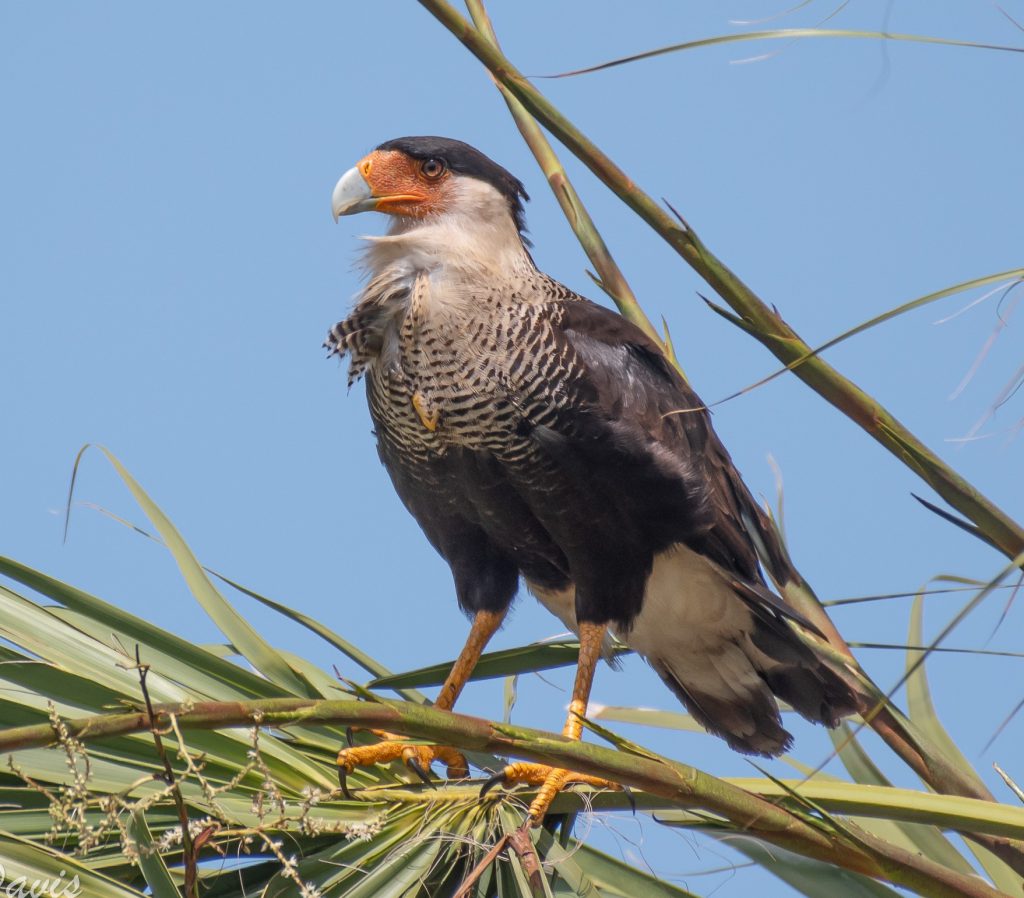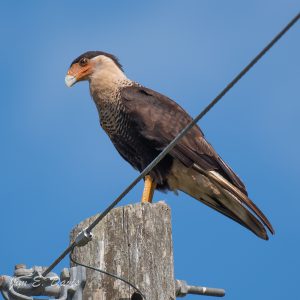Common Name: Crested Cara Cara
Status: Native Species
Scientific Name: Caracara plancus
Occurrence: Year-round Species

Identification: The cara cara is a decent sized bird, having an average length of about 22” and a wingspan averaging 49”. Adults are black and white, having white feathers on its cheek and chin area. The neck is speckled black and white. In flight, you can see the outer white flight feathers and white undertail. It is called “crested” because on its crest are dark black/brown feathers that extend down to the nape. Crested cara cara’s have a very large, thick bill. The bill has predominately orange skin, but has a bluish grey tip. They have big eyes and long orange legs with sizeable talons. There is no sexual dimorphism within the species, meaning males and females look very similar. Juveniles differ in being more brown in color and a solid white neck.
Description: You will usually see cara cara’s in open field settings, soaring above looking for food or perched on a powerline, fence post, or in cabbage palm. They will also be seen walking or running on the ground. The cara cara mating ritual is unique. They will stand and face each other, tossing their heads back and forth while making a guttural sound. Once mated, the cara cara will bond for years with its mate. Both males and females construct their nest, comprising of sticks, vines, and shrub material. Average clutch size in Florida consists of two eggs, with an average incubation time of 31 days. Eggs in Florida have been observed from September to April. Young become airborne in about 6 to 8 weeks. The mated pairs will continue to use the same nesting sight and become very territorial during the mating season which is from January to March. Juveniles may stay with the parents for a couple of weeks forming little family groups. As in several family groups of bird species, adults and juveniles will preen each other.

Diet: The cara cara is known as a carrion eater. You can find this bird feeding with black vultures and turkey vultures. Carrion is not the only food on the menu. The cara cara will hunt small mammals, birds, and will even wade in shallow water to get fish. Eggs, reptiles, and amphibians are also a part of its diet. Their feeding behavior is diverse. They have been known to fly and chase down their prey. Often, they will locate their prey, land, and walk or run to it. You would think with that large beak, they can easily tear into a fresh carcass. That is not the case. They have to wait until a vulture arrives to start the process of tearing flesh.
Interesting Facts:
- ‘Caracara’ comes from a South American Indian name, based on the bird’s call.
- The crested cara cara is also known as the “Mexican Eagle” in Central and South America.
- The crested cara cara is actually a falcon.
- The crested cara cara is listed as an uncommon bird in the United States.
- Allopreening, which is what cara cara family groups do, is the term of birds who preen each other.
- Populations in the United States have declined, mostly due to habitat destruction and hunting.
- The cara cara is protected as a threatened species by the Federal Endangered Species Act and as a Federally-designated threatened species by Florida’s Endangered and Threatened Species Rule.
Cover Photo and Other Photo Credit: Jim E. Davis
Pictures may not be used unless receive written permission from Jim E. Davis
Pictures must be used for educational purposes only.
References: https://www.allaboutbirds.org/guide/Crested_Caracara/lifehistory
https://www.audubon.org/field-guide/bird/crested-caracara
https://myfwc.com/wildlifehabitats/profiles/birds/raptors-and-vultures/crested-caracara/
https://txtbba.tamu.edu/species-accounts/crested-caracara/
 0
0
